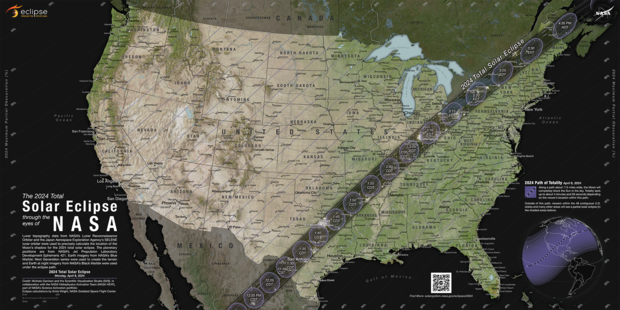Solar eclipse maps show 2024 totality path, peak times and how much of the eclipse you can see across the U.S.
A total solar eclipse crosses North America on April 8, 2024, with parts of 15 U.S. states within the path of totality. Maps show where and when astronomy fans can see the big event.
The total eclipse will first appear along Mexico's Pacific Coast at around 11:07 a.m. PDT, then travel across a swath of the U.S., from Texas to Maine, and into Canada.
About 31.6 million people live in the path of totality, the area where the moon will fully block out the sun, according to NASA. The path will range between 108 and 122 miles wide. An additional 150 million people live within 200 miles of the path of totality.
Solar eclipse path of totality map for 2024
The total solar eclipse will start over the Pacific Ocean, and the first location in continental North America that will experience totality is Mexico's Pacific Coast, around 11:07 a.m. PDT on April 8, according to NASA. From there, the path will continue into Texas, crossing more than a dozen states before the eclipse enters Canada in southern Ontario. The eclipse will exit continental North America around 5:16 p.m. NDT from Newfoundland, Canada.
The path of totality includes the following states:
- Texas
- Oklahoma
- Arkansas
- Missouri
- Illinois
- Kentucky
- Indiana
- Ohio
- Pennsylvania
- New York
- Vermont
- New Hampshire
- Maine
Small parts of Tennessee and Michigan will also experience the total solar eclipse.
Several major cities across the U.S. are included in the eclipse's path of totality, while many others will see a partial eclipse. Here are some of the best major cities for eclipse viewing — if the weather cooperates:
- San Antonio, Texas (partially under the path)
- Austin, Texas
- Waco, Texas
- Dallas, Texas
- Little Rock, Arkansas
- Indianapolis, Indiana
- Dayton, Ohio
- Cleveland, Ohio
- Buffalo, New York
- Rochester, New York
- Syracuse, New York
- Burlington, Vermont
Map of when the solar eclipse will reach totality across the path

The eclipse will begin in the U.S. on the afternoon of April 8. It will first be visible as a partial eclipse beginning at 12:06 p.m. CDT near Eagle Pass, Texas, before progressing to totality by about 1:27 p.m. CDT and progressing along its path to the northeast over the next few hours.
NASA shared times for several cities in the path of totality across the U.S. You can also check your ZIP code on NASA's map to see when the eclipse will reach you if you're on, or near, the path of totality.
How much of the eclipse will you see if you live outside of the totality path?
While the April 8 eclipse will cover a wide swath of the U.S., outside the path of totality observers may spot a partial eclipse, where the moon covers some, but not all, of the sun, according to NASA. The closer you are to the path of totality, the larger the portion of the sun that will be hidden.
NASA allows viewers to input a ZIP code and see how much of the sun will be covered in their location.
Could there be cloud cover be during the solar eclipse?
Some areas along the path of totality have a higher likelihood of cloud cover that could interfere with viewing the eclipse. Here is a map showing the historical trends in cloud cover this time of year.
You can check the latest forecast for your location with our partners at The Weather Channel.
Where will the solar eclipse reach totality for the longest?
Eclipse viewers near Torreón, Mexico, will get to experience totality for the longest. Totality there will last 4 minutes, 28 seconds, according to NASA.
Most places along the centerline of the path of totality will see a totality duration between 3.5 and 4 minutes long, according to NASA. Some places in the U.S. come close to the maximum; Kerrville, Texas, will have a totality duration of 4 minutes, 24 seconds.
What is the path of totality for the 2044 solar eclipse?
After the April 8 eclipse, the next total solar eclipse that will be visible from the contiguous U.S. will be on Aug. 23, 2044.
Astronomy fans in the U.S. will have far fewer opportunities to see the 2044 eclipse than the upcoming one on April 8. NASA has not yet made maps available for the 2044 eclipse, but, according to The Planetary Society, the path of totality will only touch three states.
The 2024 eclipse will start in Greenland, pass over Canada and end as the sun sets in Montana, North Dakota and South Dakota, according to the Planetary Society.
- In:
- Eclipse
Aliza Chasan is a digital producer at 60 Minutes and CBSNews.com. She has previously written for outlets including PIX11 News, The New York Daily News, Inside Edition and DNAinfo. Aliza covers trending news, often focusing on crime and politics.
TwitterDisclaimer: The copyright of this article belongs to the original author. Reposting this article is solely for the purpose of information dissemination and does not constitute any investment advice. If there is any infringement, please contact us immediately. We will make corrections or deletions as necessary. Thank you.





